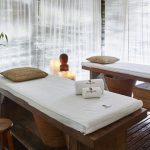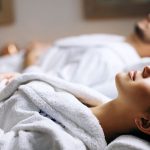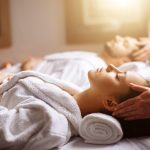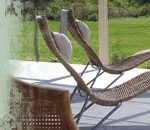Benefits of a Health Retreat
The water in the spa facility is treated without chlorine. The water is high in mineral bore water and re-energised with Ecovortek, kept hygienic with UV lights and hydrogen peroxide.
Research has shown the benefits of hydrogen peroxide. It oxygenates the body and cleanses the blood. Hydrogen peroxide has great healing properties for all skin disorders and infections. The skin feels hydrated and soft, smelling beautiful.
In the spa the space is designed to encourage harmony and relaxation.
Entry to the Wellness Centre
Enjoy 2 hours of bliss; this wet area is like nothing you have experienced. Our 3 section spa, massages your whole body. Then pop across to the 2 different temperature regulated Infrared saunas for a gentle, slow increase of your body temperature. After sitting back and relax use the hot sauna with a steam enhancement function. Cool of with a Kneipp shower before dipping in to the cool water plunge pool.
Protocol for the Wellness Centre
Come in a 15 minutes before your appointment to our reception lounge and enjoy a special blend of house tea to stimulate the sweat-glands, followed by a glass of re-energised water while we talk about your visit at the retreat. The visit starts with a shower in the change room using sulphate free body wash and shampoo. Hair must be washed before you go into the sauna and spa. You are provided with all the garments and towels you need.
Bathing suits made of artificial fibre could cause a stroke since your body does not have adequate release for the heat. Observe your body while using this facility and respect and respond to the signals. Duration given is a guideline only.
How to use the facility
The first step before entering the spa facility is undressing and leaving your clothes in the change room locker. Washing before entering takes place in the shower in the change room. Washing is an enjoyable part of the ritual. Each body part is soaped, washed and rinsed off with warm water from a rain shower. Hot water prepares you for the heat of the spa facility. We supply sulphate free shampoo and shower gel. Hair must be washed and wet when entering a sauna and to avoid hair products in the spa water.
Disposable garments are supplied in your locker and to be worn after the shower.
The facility is warm and steamy. Step into the spa or hot pool, relax and enjoy the experience with all your senses. Follow the step by step protocol given for spa and 3 types of saunas followed by Kneipp shower and cold plunge pool or for the more experienced spa user enjoy the facility to your level of health.
After drying and dressing in your silk kimono you can rest in the tranquility room and replenish the fluid intake while looking out to the relaxation garden. Repeat using the facility and feel your worries to be left behind you and be revitalized by the experience.
Step by step for the best benefits
[1] Hydrotherapy Massage Spa section 1, 2 & 3 massages your whole body in 35° C Water
[2] Pat yourself dry before entering any sauna
[3] Infrared Sauna approximate temperature 40 ° C for 15mins
[4] Infrared Sauna approximate 45-60 ° C for 15mins
[5] Shower is a must after a sauna. Try to have the water tempered to cool.
[6] Traditional hot Sauna (80-100 ° C) for 10-15mins. Poor water over the stones
for extra heat.
[7] Shower is a must after a sauna. Sit down on the stool and start with cool water first,
turn as cold as possible following the correct application.
[8] Cold plunge pool as long as comfortable if you are strong and healthy.
[9] Pat yourself dry and rest in your Kimono in the relaxation room for 10mins or go
outside to breathe some fresh air to replenish oxygen until your pulse slowed down.
[10] Choose to either;
- go back to enjoy the spas
- repeat steps 6 to 9
- return to the change room. Gently pat your body dry and massage in a hydrating oil while you’re still damp
Hydrotherapy benefits
- Releases heavy metals from the body
- Strengthens the immune system
- Provides detoxication through better water management within the body
- Assist with weight loss, 500 grams of sweat consumes 300 cal
- Relieves stress
- Improves sleep, lifts depression and winter blues
- Has a balancing effect on the psyche and emotions
- Eases pregnancy and childbirth
- Relieves bad back and muscle tension
- Has a protective effect on the arteries, especially important for diabetics
- Improves heart circulation and oxygenation
- Helps regulate high blood pressure
- Helps the respiratory system, hay fever and asthma
- Reduces colds and flu
- Speeds healing of acne and skin problems
- Gives you younger looking skin trough better nourishment from within
- Provides deep, total-body cleansing
Hydrotherapy Massage Spa
The healing properties of water were recognized by the Greek physician Hippocrates (c.460-377 BC) centuries before the birth of Christ, but certainly known long before then. Fundamentally, hydrotherapy works by stimulating the body’s own processes. Its underlying principles have remained unchanged for centuries but, in recent years, they have finally received the boost of scientific proof (Father Sebastian Kneipp has known for over 100 years) and the physiological effects of hydrotherapy are now seen to be quite remarkable.
The aim of hydrotherapy is to use water to stimulate our biggest organ, the skin. It increases blood flow and stimulates the flow of lymph and brings fresh oxygenated blood and other nutrients to the cells. Warm water dilates the blood vessels, where as cold water restrict the blood vessels The thermo receptor in the skin transmits via the nervous system impulses of hot and cold sensations that help regulate the body temperature more efficient.
Being submerged in water, especially warm water makes the muscles relax and joints soften, as well as bringing a state of tranquillity to the mind. The massage of water in the form of underwater jets helps relieve stiffness and eases pain and tension.
Water is related to the emotion and has a comforting feeling of renewal upon it. Spas are a concept which existed since Roman times, rewritten for the contemporary scene, an altar of self-preservation for health, beauty and relaxation.
Lasting beauty comes from deep within the body and mind. The balance between inner and outer beauty helps to get back in touch with sensuality. While people were taking these various water cures, they discovered that there are other benefits, besides those to their physical health. Energy levels increased, minds became simultaneously calmer and more alert, people were less vulnerable to stress.
Traditional sauna
Sauna is sweating induced by high, dry heat followed by rinsing or immersing in cold water, increasing total circulation. When a body part is not well circulated the energy flow through our channels, or meridians, become sluggish, even blocked. Increasing circulation with spas, saunas and hot-cold treatments restore the flow of body energy. The contrast on hot and cold trains the blood vessels to react quickly in order to adjust the body temperature to heat or cold. It strengthens veins and arteries and keeps them elastic.
The skin is our “third kidney” by taking over waste and water management if the kidneys are overloaded. Sweat rinses away metabolic waste and attached bacteria. The sauna puts less strain on your cardiovascular system than other daily activities. The blood pumped by the heart almost doubles, but with only a 50-percent increase in beat frequency. Raised blood pressure sinks.
Your pulse will get faster when talking, sitting or standing in the sauna, so lie down, relax and be quiet to help your heart. Conversation alters your mindset, changes your blood pressure and prevents normal relaxation. The sweat glands perform better when you are relaxed.
Dousing the rocks with water will add another fifteen to twenty heartbeats for about one minute. A pulse rate higher than this could indicate weakened heart muscle or other problems and could be a contradication for the sauna. The use of cold water after the hot sauna is paramount.
People with high blood pressure should use a hose, such as the one used for Kneipp water therapy. Avoid the cold immersion tub if you have hypertension, but regular sauna visits contribute to stabilization of high blood pressure if the sauna is done correct.
Listen and respect the signs of your body. No one can tell better then you.
How to apply cold water
Apply cold water from the feet up and cover the skin like a mantle. Start at the furthest away spot from the heart, the right little toe. Move up the leg; repeat on your left leg. Now point the water into your right hand, move it up to the shoulder and let it run over the right half of your body, moving the hose back and forth covering front and back. Do the same with the left arm. Now bend forward, point the water at your chest and make a figure eight several times. Straighten up and run the water up the right leg again. Make a spiral around the abdomen starting on the lower right side. Rinse your face and behind your ears and over your head slowly while you sit down.
Infrared Sauna
Infrared radiant energy (not the hot air of traditional sauna) directly penetrates the body’s tissues to a depth of over 1.5 inches. The infrared system may induce up to 2-3 times the sweat volume of a hot air (traditional sauna) while operating at a significantly cooler air temperature range. The lower heat range is safer for those not accustomed to regular saunas.
Father Sebastian Kneipp firmly believes in a gentler approach of promoting the bodies self healing ability. By using infrared sauna first the body warms up slower and gentler. Too hot too quick can be uncomfortable and hinders the relaxation. The body needs to be relaxed in order for the sweat-glands to work efficient.
Infrared sauna helps generate two or three times the sweat production of a hot air sauna. A person can easily sweat 1000 grams, burning of 600-800 cal with no adverse effects. While the weight of the water loss can be regained by drinking water, the calories consumed will not be.
Both Saunas induce sweating. Hot and cold saunas are best for circulation, while infrared focuses on a gentler warm up and cool down approach and are an easy introduction to newcomers.






